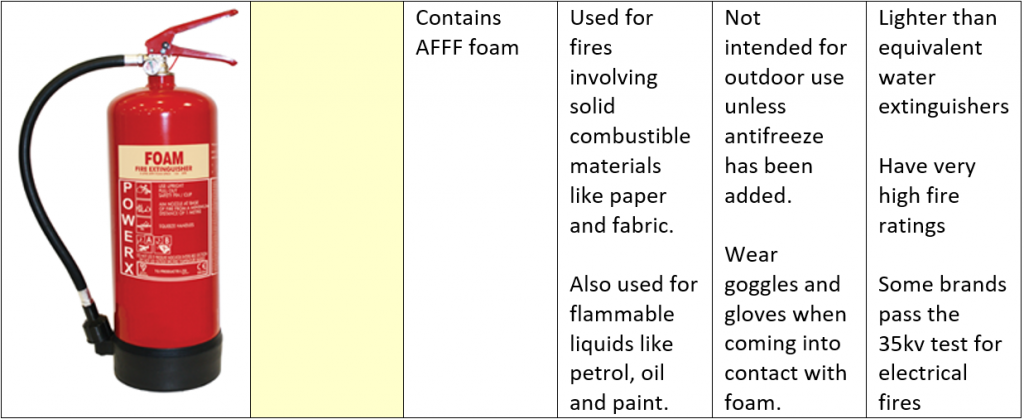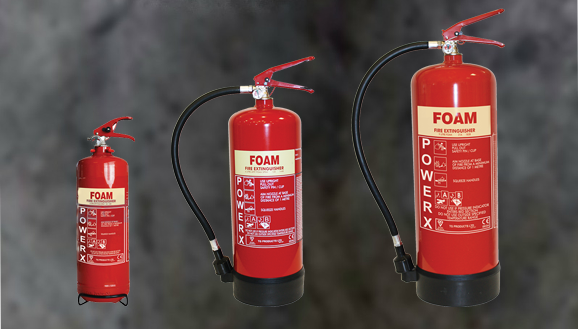Chapter 2 – The Foam Fire Extinguisher.
In this second chapter of our guide to the different varieties of fire extinguisher we will be looking at the foam fire extinguisher in detail. In our years in business the foam fire extinguishers versatility and high fire rating has made it a consistently popular option for both homes and businesses alike. Read on to find out if the foam fire extinguisher is suitable for you.
The Overview:

The Details:
The foam fire extinguisher is one of the most popular and versatile brands of fire extinguisher available on the market. It is light and easily portable, and superb at fighting some of the more common types of fire. They are the extinguishers most commonly depicted on television and one of the most instantly recognisable fire-fighting aids.
Fires can be classified into different categories based on their fuel source. Foam fire extinguishers are designed to be effective on Class A and Class B fires. Class A fires, as we explained in our article on water fire extinguishers, are fires involving combustible solids- like card, or wood. Class B fires are fires involving flammable liquids such as petrol, oil, even paint. Class B fires prevent a different hazard depending on whether the liquid is contained or free-flowing, but a foam fire extinguisher is equipped to deal with either situation. Some foam fire extinguishers pass the 35kv test for use on electrical equipment but if you are dealing with a live electrical fire and are unable to switch off the power source you are advised to use a carbon dioxide fire extinguisher instead.
Is a Foam Fire Extinguisher Right For You?
Foam fire extinguishers are very popular for both home and commercial use. If you have a business which works with petrol or oil- such as a garage or car dealership you may find a foam fire extinguisher very useful. Paints and dyes are less well-known fire hazards, but artists, clothing manufacturers, painters and decorators can also make use of this extinguisher. The foam fire extinguisher can also be used anywhere that a Class A hazard is present, so in addition to their coverage of liquid hazards they can also be used in hotels, retail stores, anywhere that a solid hazard might be present. Schools, libraries and other public institutions often also find good use for foam fire extinguishers.
What Kinds of Foam Fire Extinguisher Are Available?
There are a couple of different types of foam fire extinguisher available, though only one is usually available commercially. To meet BS EN3 requirements the canister for a foam fire extinguisher should be red, with a cream panel above the operating instructions on the side, and FOAM written in capital letters. Where there is doubt, a fire extinguisher identification sign should be available nearby.
The most commonly available foam fire extinguisher is the AFFF foam extinguisher. AFFF stands for Aqueous Film Forming Fluid. These are the extinguishers you will find in homes and businesses across the country. Many AFFF foam extinguishers have an anti-freezing agent added making them suitable for outdoor use, but not all do, so it is worth checking before you buy if your extinguisher is intended for an outdoor siting.
The other type of foam extinguisher which may be encountered is a CAFS extinguisher but these are rarely found in the UK. They are almost exclusively used by firefighters attempting to put out wildfires and they use a type of dry foam which is designed to spread over a large area.
Here at Chase Fire we have an excellent, carefully curated selection of AFFF foam extinguishers. If you think a foam fire extinguisher would be suitable for your home or business, our friendly advisors will be more than happy to help you to find the right one for you. Call us on 01785 252568
How do Foam Fire Extinguishers Work?
How does foam put out a fire? The fire tetrahedron has four essential components, heat, oxygen, fuel and a chemical reaction. AFFF foam works in two separate and equally effective ways. First the foam forms a barrier between the fuel and the oxygen in the air, smothering the fire, and then the foam acts as a coolant, removing the heat to prevent re-ignition. This dual strategy makes foam fire extinguishers some of the highest rated available when it comes to fire-fighting efficacy.
How Should I Store and Maintain a Foam Fire Extinguisher?
Any fire extinguisher should be commissioned and installed by a BAFE certified engineer. Foam fire extinguishers should be sited 30m from a recognised hazard if being used for Class A fires, and 10m from a recognised hazard if used for Class B fires. You should be performing a visual inspection on your foam fire extinguisher at least once a month, to check the pressure gauge if one is available and to check for any dents, leakage, or signs of tampering. A full inspection should be carried out every 12 months from the date of installation by a qualified individual. Every 5 years the canister should be completely discharged and refilled.
How Do I Use A Foam Fire Extinguisher?
| P | Pull the pin from the side of the handle |
| A | Aim the hose at the base of the flames, standing about two metres away for Class A fires. For Class B fires aim at a vertical surface near the fire where possible, to prevent the force of the foam pushing the flaming liquid away. |
| S | Squeeze the handle to release the foam in a steady flow |
| S | Sweep the hose from side to side so that the foam envelopes the entirety of the burning area when dealing with a Class A fire. When attempting to put out a Class B fire, build up a thick layer of foam over the burning area, being careful not to spread the fire. |
IMPORTANT:
- Never turn your back on a fire
- Always have an escape route planned
- Call the fire and rescue services if you encounter any difficulties
- Leave the building if you fail to put out the fire or if it re-ignites at any point

